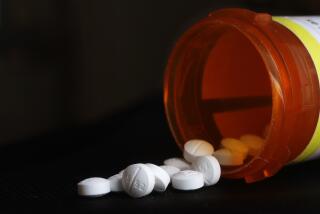To be safe, keep track of pills
- Share via
NOBODY knows how many deaths are caused by medication errors.
But every year, more than 1.5 million Americans are harmed by these preventable mistakes, which cost the country well in excess of $3.5 billion to treat, according to a sobering report released this summer by the Institute of Medicine, a prestigious group of scientists that advises the government.
And that’s just the people believed to be injured by drug errors.
Countless others are not harmed but could have been because they took, or were given, the wrong drugs, the wrong dose of the right drugs or drugs that were appropriate but less safe than alternatives. The report also estimated that the average hospitalized patient experiences one medication error every day.
Many of the group’s recommendations to reduce errors are things that individual consumers can’t do much about, such as processing all prescriptions electronically by 2010, making drug labels and inserts more intelligible, standardizing drug information and improving access to it through the Internet and a 24-hour national telephone hotline. But that doesn’t mean consumers are helpless.
“Nothing that patients can do by themselves will make them truly safe,” said Dr. Albert Wu, a professor at the Johns Hopkins Bloomberg School of Public Health in Baltimore and a coauthor of the report. “But they can start doing things that can make them safer.”
To keep doctors from prescribing inappropriate drugs, the most important thing is to make a list of all your medications -- including vitamins, herbal remedies and dietary supplements -- keep it up-to-date and take it with you every time you go to the doctor’s office or hospital. Many people see multiple doctors, and it’s often only the patient or a family member who knows all the drugs involved.
Keeping on top of medications is especially important in the hospital.
“It’s critical for patients -- or family members -- to be involved as much as they can to make sure the patient gets the right medications at the hospital,” said Dr. David Bates, chief of general internal medicine at Brigham and Women’s Hospital in Boston and a coauthor of the report.
This means paying attention every time a nurse gives a medication, said Dr. Tom Rosenthal, chief medical officer for UCLA Health Care, which runs three hospitals. Nurses should match not just your name, but your birth date and patient ID number with the information on the medication order. And family members should ask which medication is being given.
Just as important, for family and doctors, is keeping track of hospitalized patients’ kidney and liver function. Simply lying in bed for several days reduces blood flow to the kidneys and therefore, kidney function. If the kidneys aren’t processing a drug normally, a dose that is safe in someone with good kidney function may be too high in someone with poor kidney function. The same goes for liver function.
At the time of discharge, get a written list of your drugs and go over it with a nurse or doctor to make sure newly prescribed drugs won’t interact adversely with drugs you are already taking. Take notes.
Similarly, when you pick up drugs at the pharmacy, or open a package of mail-order medications, check right away that these are the correct medications and doses. If you are unsure, ask the pharmacist. Sometimes druggists substitute one drug for another, which may be fine, but you should notice -- and ask -- if you’re suddenly getting a green triangular pill instead of the little white one you’re used to.
At the doctor’s office, ask the nurse or doctor to write down the name of any newly prescribed medication, why you’re taking it and how often to take it.
In a political sense, consumers can lobby for the widespread changes that could do the most to reduce drug errors.
Obviously, said Dr. Brent James, vice president for medical research at Intermountain Healthcare in Salt Lake City, everyone can’t go to the three hospitals worldwide that he deems best at reducing medication errors -- Brigham and Women’s, the LDS Hospital in Salt Lake City (which is in his hospital network) and the Royal North Shore Hospital in Sydney, Australia.
But consumers can push their own hospitals to implement the most promising changes. For one thing, he said, they can ask hospital personnel how the hospital is doing on medication errors. The good hospitals, he said, often report the highest error rates simply because they are keeping diligent track of such things. Over time, James said, these rates typically go down if the hospital works to correct errors.
Another change worth lobbying for is making sure that every dose of every drug prescribed is ordered by a doctor on a computer. Only about 15% of hospitals do this now, said Bates of Brigham and Women’s.
The potential advantages of this are huge, not just for picking up potential drug interactions but for more subtle things as well. Allergic reactions account for 28% of adverse drug events, said James, but some drugs are much more likely to cause such problems than others, so checking a computerized list of alternative drugs can be helpful.
Patients can also lobby doctors and hospitals to prescribe drugs electronically, which can reduce errors partly because typed prescriptions are more legible than those in doctors’ handwriting and partly because e-prescribing can include checking for drug interactions.
In one large Michigan medical practice, physicians have caught 98,000 potentially harmful drug errors before they happened in the year and a half since switching to e-prescribing, said Matthew Walsh, of the Health Alliance Plan, part of the Henry Ford Health System.
Beth Israel Deaconess Medical Center launched its new e-prescribing program in June, said Gail A. Fournier, a partner at Computer Sciences Corp., which is working on sharing computerized information among health institutions. Among other things, she said, the system will allow doctors to see which prescriptions are actually filled, which may help with patient “compliance” in taking the drugs they need.
Bottom line? Medications can heal, but they can also harm. To increase chances of the former and reduce chances of the latter, know what you’re taking -- and let your healthcare providers know too.






